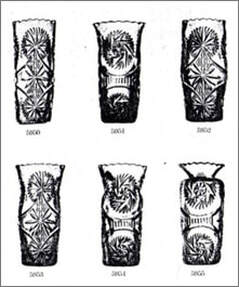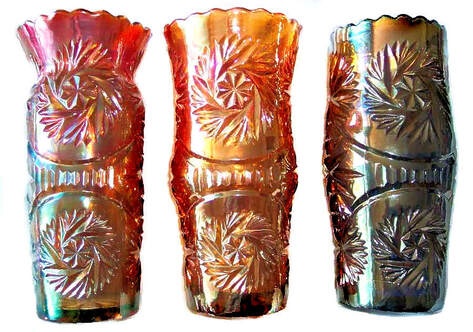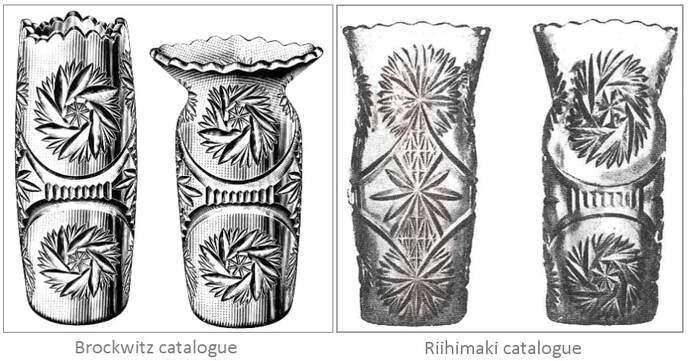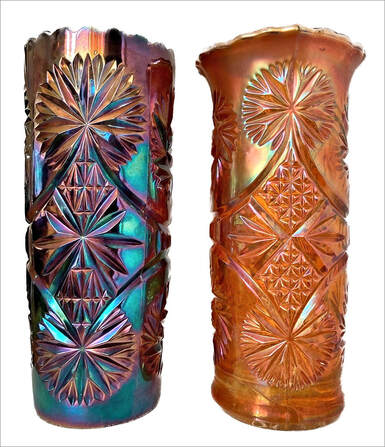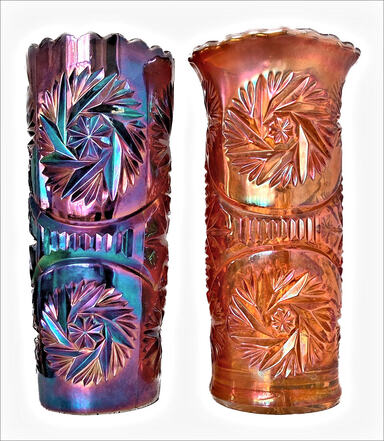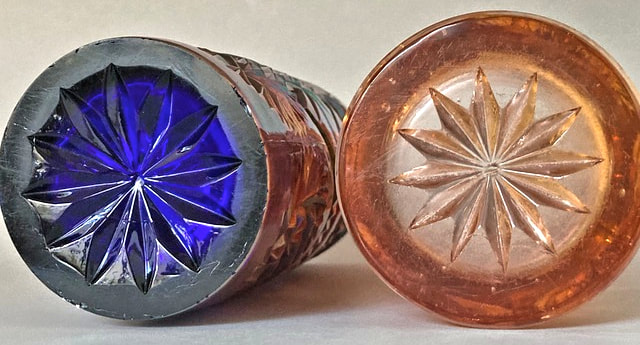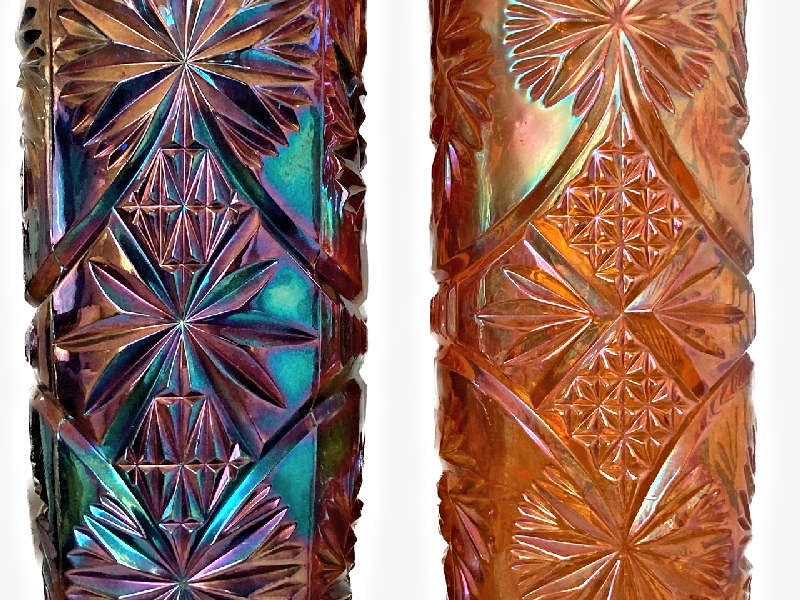Collectors Facts - Elektra Vases, Brockwitz and Riihimaki
Thanks to Joan Doty
An expanded version of the feature in our Carnival NetworK ezine 94, March 2023: “Solving the Elektra Mystery”.
An expanded version of the feature in our Carnival NetworK ezine 94, March 2023: “Solving the Elektra Mystery”.
There’s a special delight in seeing the emerging solution to a long-standing puzzle and it’s thanks to vase expert, Joan Doty, that we are able to share the answer to the mystery surrounding the Elektra vases - how can you tell who made them? But first, for those unfamiliar with this beauty, let’s briefly re-wind and take a quick look at the back story.
What’s the Elektra vase?
It’s a statuesque, cylinder vase, around 10 inches high, comprised of four panels wrapped around the vase – two panels with a whirling star design alternating with two panels of a sunburst design.
The catalogue evidence.
The Elektra pattern is shown in Brockwitz (Germany) catalogues from 1926 in a wide range of shapes (although only a few of the shapes are so far known in Carnival). Now, don’t take that date at face value to infer that it’s the date that Brockwitz first made Elektra. We are not aware of any Brockwitz catalogues in collectors’ possession between the dates 1922 and 1925 – so it is entirely possible that the Elektra pattern was introduced by Brockwitz as early as 1922.
The Elektra pattern was also copied and made by Riihimaki (Finland) in around 1927, using moulds made by Kutzscher – a German firm that specialised in creating moulds according to the customer’s requirements (which often involved a certain amount of plagiarism).
|
So, the Elektra vase is shown in the catalogues of both makers – Brockwitz and Riihimaki, and various top shapings are known. Composite image showing six slightly different shapes
in Riihimaki's Elektra vases in their catalogue. |
Our trio of Riihimaki Elektra vases, all found in Finland, showing the
whirling star panel. Left to right they are marigold, amber and blue. |
Two Sides to Every Story
The Riihimaki catalogues show the designs of both side panels on the vase - the whirling star design and the sunburst design. We personally have three Elektra vases that we found in Finland several decades ago – shown above, and all three of them matched the Riihimaki catalogue drawings.
|
We have previously studied Brockwitz and Riihimaki versions of the Elektra pattern in catalogue information that was available to us. Based on this, it seemed as though there was no readily apparent way to distinguish between the Brockwitz and Riihimaki versions of the large cylinder vase.
Crucially (as it turned out), the Brockwitz catalogues showing the Elektra vase illustrate only one side panel – the side with the whirling star pattern. So, in the absence of other information, we had no idea that one side panel of the vase was so distinctly different in the two makers’ versions (Brockwitz and Riihimaki). That is … until we heard from Joan Doty. Joan contacted us with the exciting news that she had just acquired a second Elektra vase – and it was slightly different than the one she already had. Joan’s excellent observations and her beautiful photos shown below, tell the fascinating and illuminating story. And note – there are two sides to this puzzle! |
Extracts from the Elektra illustration in Brockwitz and Riihimaki catalogues. The Brockwitz catalogue shows only one side panel design (the whirling star), whereas the Riihimaki catalogue shows both panel designs (the sunburst and the whirling star).
|
Read on to discover how the revelation came about.
When Joan acquired her recent example she immediately spotted important distinctions between the two makers and the solution to the puzzle became clear. Two wonderfully clear and detailed pictures below, courtesy of Joan, show an Elektra vase in blue, made by Riihimaki, and in marigold, made by Brockwitz.
When Joan acquired her recent example she immediately spotted important distinctions between the two makers and the solution to the puzzle became clear. Two wonderfully clear and detailed pictures below, courtesy of Joan, show an Elektra vase in blue, made by Riihimaki, and in marigold, made by Brockwitz.
|
Elektra vases in blue and marigold showing the sunburst panel design.
We now know that the blue one on the left is Riihimaki, and the marigold one on the right is Brockwitz. |
The same blue and marigold Elektra vases showing
the more familiar panel design of whirling stars and a central band of vertical lines. |
Photos courtesy Joan Doty.
The central section of the sunburst design panel is very different.
Although the concept is the same, the interpretation and execution is very different. Joan describes it perfectly: “Two rows of long, thin triangles on the Riihimaki, tiny squares bisected into tiny triangles on the Brockwitz.”
|
The sunbursts are not exactly the same – in fact, the more you look, you see other subtle differences too. The blue vase is clearly the Riihimaki version as shown in the catalogue. The marigold vase is the Brockwitz version (showing the side panel not depicted in Brockwitz catalogues). Joan’s close-up photo, right, clearly illustrates the differences. The Marie Another difference that Joan has observed is on the base – the marie. The Riihimaki marie has a diameter of 3.25 inches, while the diameter of the Brockwitz marie is 3.5 inches. Joan describes them in more detail for us: “The stars are very different sizes as well. The tips on the large blue Riihimaki star are a quarter of an inch from the edge of the marie, while the tips of the slender marigold are three quarters of an inch from the edge.” |
Riihimaki’s Elektra on the left and Brockwitz’ on the right.
The central diamond sections are very different indeed. This sunburst panel design is not illustrated in the Brockwitz catalogues. Photo courtesy of Joan Doty. Maries of the two Elektra vases:
Riihimaki on the left (blue) and Brockwitz on the right. Photo courtesy Joan Doty |
Grateful thanks to Joan Doty for enabling us all to distinguish between Brockwitz and Riihimaki versions of the Elektra vase.
See more Collectors Facts
